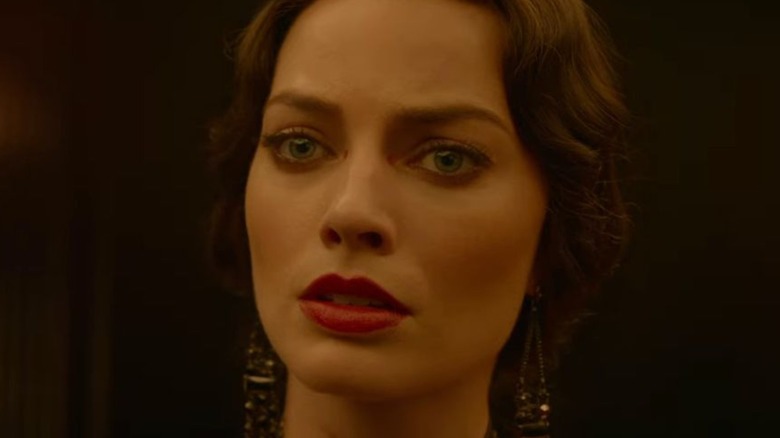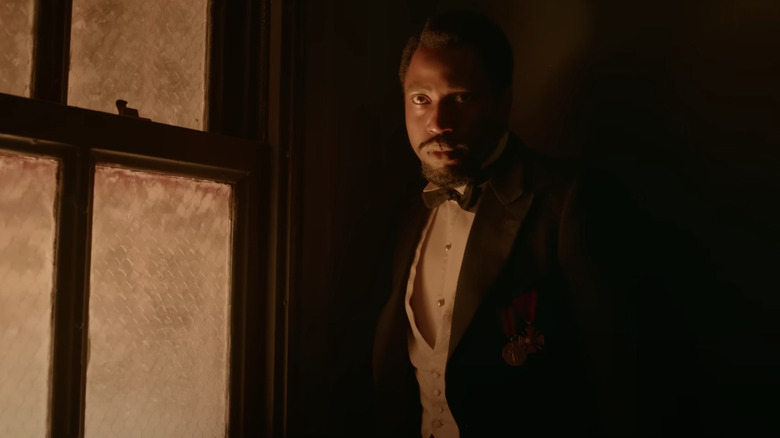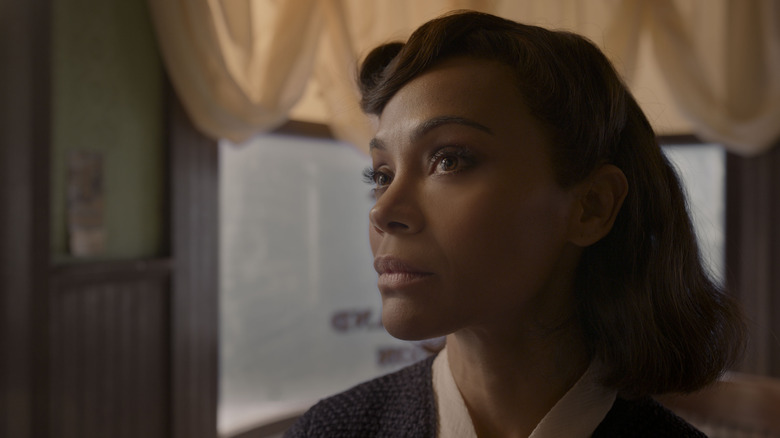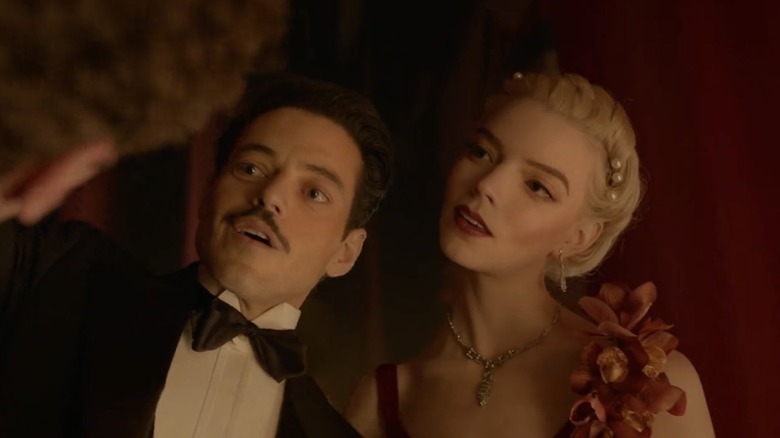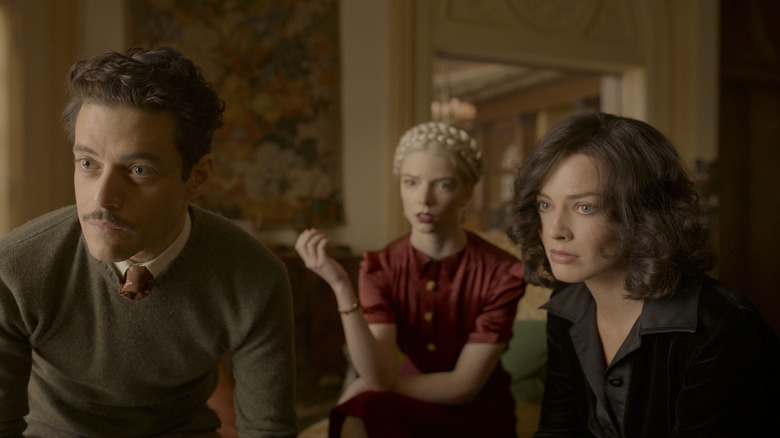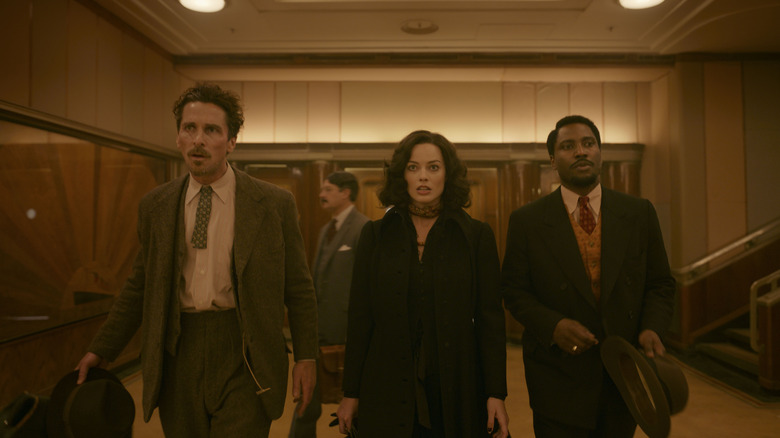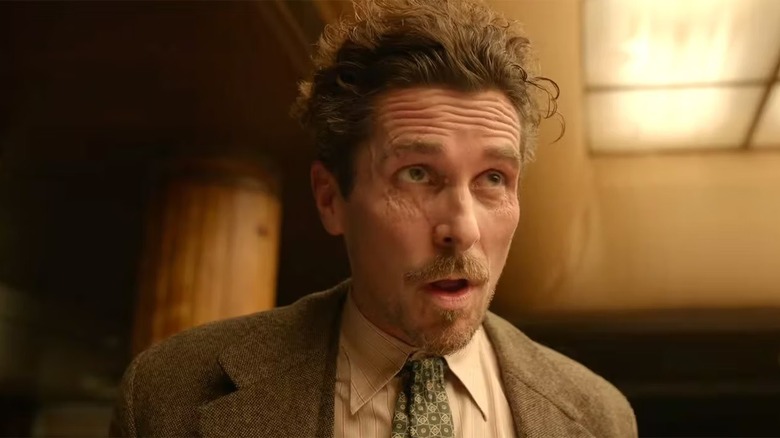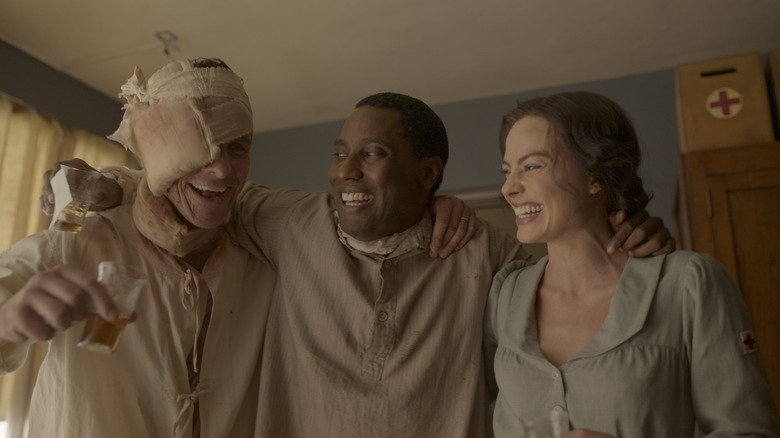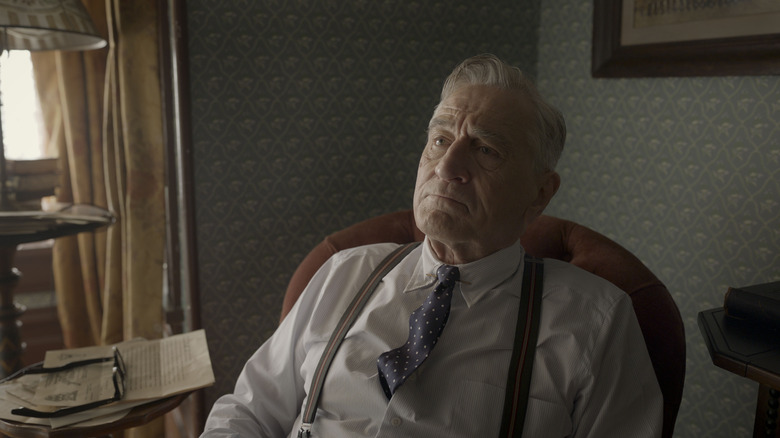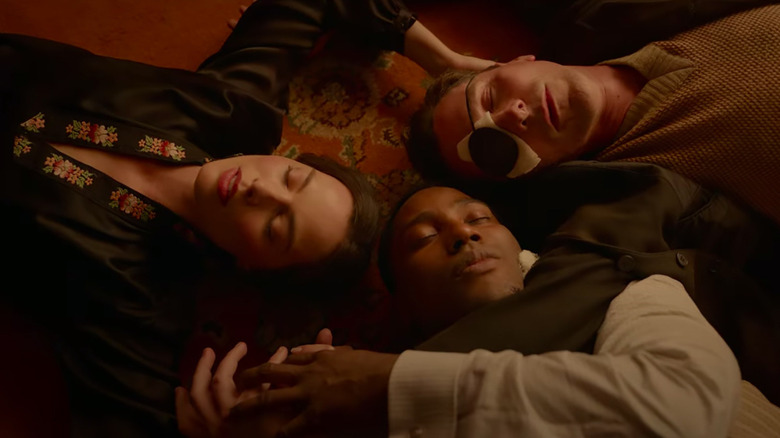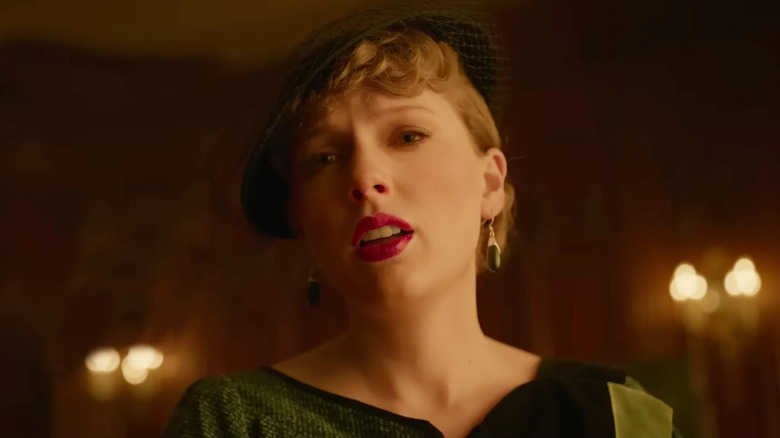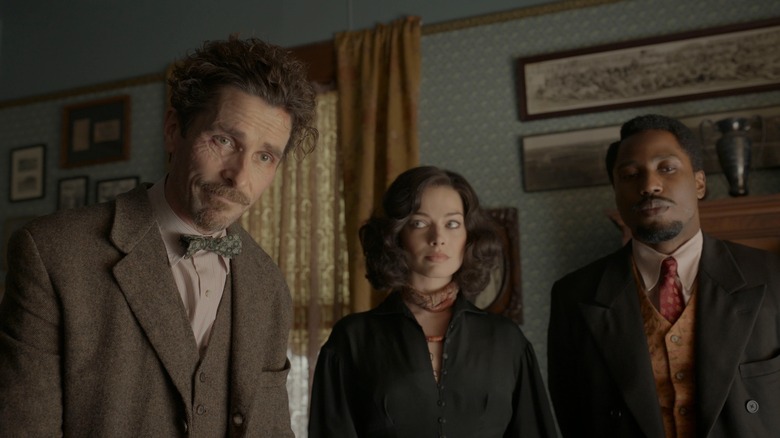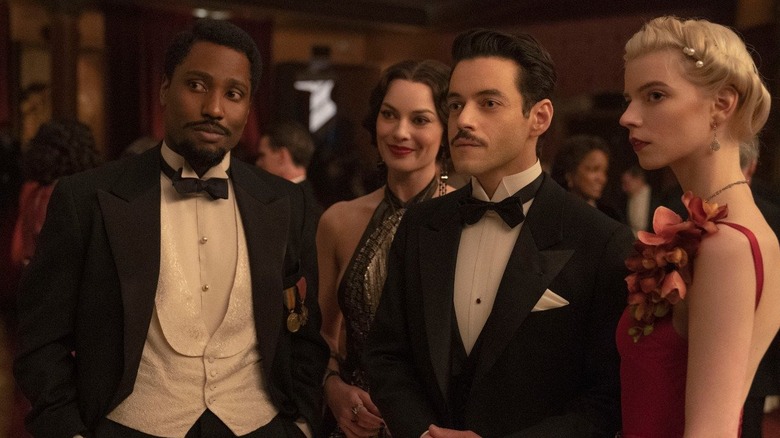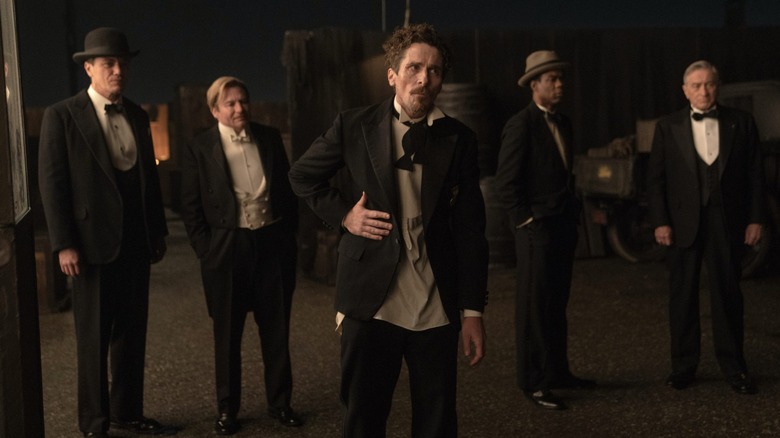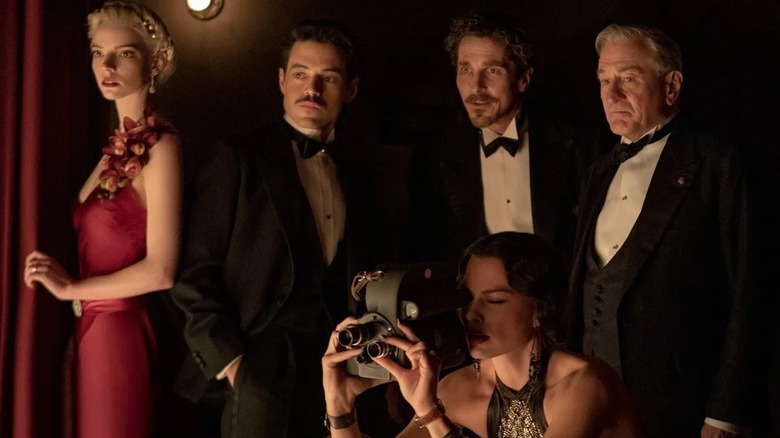The Best And Worst Things About Amsterdam
Contains spoilers for "Amsterdam."
After a lengthy absence, writer-director David O. Russell, the filmmaker behind "American Hustle," "Silver Linings Playbook," and more, is back with "Amsterdam." This period crime comedy focuses on the oddball trio of doctor Burt Berendsen (Christian Bale), artist Valerie (Margot Robbie), and lawyer Harold Woodsman (John David Washington), with a star-studded cast bringing life to a menagerie of supporting characters. It's a feature that varies wildly in tone and attempts to touch on several sociopolitical issues. The ambition is apparent in Russell's screenplay, and occasionally all that audacity yields some memorably funny moments. Of course, it's no surprise that getting so many superb performers in one place also produces some laudable pieces of acting.
However, "Amsterdam" as a whole is a messy mixed bag, a film that sags when it needs to zip and often comes across as awkward when it's trying to be hysterical. It's not a flat-out disaster, but it's also a far cry from fulfilling its potential. Breaking down the best and worst things about "Amsterdam" makes the quality of the overall feature more apparent than ever. In its greatest moments, it's easy to see why all these famous faces were attracted to the project. Unfortunately, there are also the weak spots when "Amsterdam" indulges in its worst creative impulses.
Best: John David Washington's performance
Shockingly, two of the weaker performances in "Amsterdam" come from among its three leads. Neither Christian Bale nor Margot Robbie bring much to the table here (unusual for them), and both are retreading ground from better performances in their own respective careers. But if there's a saving grace to the lead trio, it's John David Washington as Harold Woodsman. Washington does some particularly strong work bringing this character to life — an extra impressive feat since, on paper, he's often stuck being a straightforward buttoned-up personality that Bale and Robbie's more oversized characters can bounce off of.
Other actors may have ended up being forgettable playing such an individual, but Washington keeps finding ways to inject subtle bursts of personality into Woodsman's quietest moments. A scene depicting Woodsman talking with Robbie's Valerie shortly after the duo has been reunited is an especially great showcase for Washington's talents. Just through his eyes and a tear trickling down his cheek, Washington communicates years of pent-up yearning for this woman who suddenly vanished from his life. So many people in "Amsterdam" come across as stylized caricatures, rather than fully-realized people. But that's never a problem for John David Washington and his consistently deeply human performance.
Worst: Suffocating narration
Initially, the narration in "Amsterdam" (most of it coming from Bale's Berendsen) seems like a necessary addition. After all, David O. Russell's screenplay begins in 1938, plunges viewers into the lives of two of the lead characters, and then flashes back in time to 1918 to establish how the three protagonists could be swept up in a murder. That's a lot of ground to cover, and some narration could help convey important information to the audience. However, "Amsterdam" ends up leaning on narration as an aggravating crutch. Rather than being used as a garnish in this cinematic dish, it becomes an intrusive ingredient that keeps undercutting critical moments of on-screen action.
Most notably, a montage sequence showing Burt, Harold, and Valerie over multiple years spent together in Amsterdam could have left an impact on the audience by communicating all the little things that lead to this trio developing an inseparable bond. Instead, Bale's pipes clog up every frame of this montage, right down to explaining comically obvious details to the viewer. The narration places a barrier between the audience and what's happening on the screen, and it's far from the only time this occurs in "Amsterdam." Brief superfluous instances when Harold or Valerie are similarly shed unnecessary light on their interior lives serve as a testament to how poorly narration is handled in "Amsterdam."
Best: Rami Malek's comic sensibilities
The comedy in "Amsterdam" often relies on a delicate brand of awkwardness, but there are some actors who manage to strike a solid tone in executing the script's wacky lines and plot twists. Surprisingly, the actor who fares best with all these elements isn't comedy veterans Chris Rock or Mike Myers, but Oscar winner Rami Malek. This might seem like a strange development, but Malek has managed to excel comedically before, in projects ranging from the "Night at the Museum" trilogy to his stint hosting "Saturday Night Live," not to mention the memorable set-piece from "Need for Speed" in which he waltzes out of an office naked. Malek's always been able to tickle an audience's funny bone, and that talent is put to great use here.
Portraying the wealthy and eccentric Tom Voze, Malek works nicely in juxtaposing his character's often ludicrous dialogue with an intensely dramatic performance. While others in the "Amsterdam" cast are working overtime to seem silly or hysterical, Malek is confident enough to know that understating things can often make them even funnier. His sense of comic timing is also commendable, and informs the movie's funniest moment, involving the demise of a walrus whose skin was used for a book cover. The only drawback to how humorous Malek is in his "Amsterdam" screen time is that it heavily reinforces how underwhelming the other comic performances in this movie can be.
Worst: Unimaginative approach to female characters
In a sprawling ensemble cast featuring multiple female characters, you'd think at least one of them would emerge as a well-written and compelling figure. The law of averages suggests that somewhere within the sizeable cast of "Amsterdam" there would have to be at least a single well-realized woman. Unfortunately, David O. Russell's script lets down talented performers like Margot Robbie, Andrea Riseborough, Zoe Saldana, and Anya Taylor-Joy, among others, by not giving them anything to do. Saldana is stuck in a thankless love interest role, for instance, while Riseborough is just a caricatured villain, with neither character allowing these performers to indulge in their respective gifts as actors.
Perhaps most disappointing of all, though, is how little Robbie gets to do as Valerie. Despite being one of the movie's three leads, she gets the least to do by far of the main trio, thanks to her character dropping out of the narrative entirely for a long stretch of time. When she does appear, we get little insight into her head, and even her fascination with making ramshackle art lacks a distinctive personality. Worse yet, in the only rare instances where two women are in the same room, they're at each other's throats. Russell can come up with all kinds of whimsical gags related to birdwatching in "Amsterdam," but he seems incapable of imagining women inhabiting complicated and fascinating characters.
Best: Production design
Admittedly, the production design of "Amsterdam" does feel hamstrung from fulfilling its fullest potential. The quasi-Wes Anderson vibes given off by the whole feature are especially felt in the whimsical touches among the sets. However, the movie's inability to go for broke on being stylized as a narrative feels like it's holding the production design back from being as imaginative as it could be. Still, the sets of "Amsterdam" do have some lovely touches, especially when they indulge in wall-to-wall bright colors. The living space of Beatrice Vandenheuvel being decked out in a bright hue of red is perhaps the best example of this kind of visual detail.
This maximalist detail doesn't just result in a memorable environment, it also reflects the excessive tendencies of the uber-wealthy Vandenheuvel family. Similarly, the light blue hue of Tom Voze's office suggests the chipper but conservative disposition of this socialite. The cramped nature of the bedroom of General Gil Dillenbeck, meanwhile, does a great job communicating how isolated this character is from the rest of the world. The avalanche of props covering this space, on the other hand, instantly conveys the rich history he's had. Sure, the "Amsterdam" sets could've been even more over-the-top and distinctive, but production designer Judy Becker still does solid work with this element of the movie.
Worst: Christian Bale's performance
Stripping Christian Bale of the opportunity to undergo a tremendous physical transformation or have an elaborate costume for the role of Burt Berendsen in "Amsterdam" would seem to tee the actor up to deliver something special for his performance here. After all, Bale's proven quite gifted at portraying everyday human beings in projects like "Ford v. Ferrari" — he doesn't need gimmicks to be a good actor. Unfortunately, Bale ends up finding other ways to inject flourishes into his acting. Wacky line deliveries and a barrage of strange physical quirks serve as the substitutes for heavy prosthetics and weight changes in his Berendsen performance.
These quirks come off less like natural extensions of who Berendsen is as a character and more like evidence that Bale was so uncomfortable not radically transforming himself physically that he had to find other ways to conceal himself. The distinctive traits he brings to the table as Berendsen are always straining for laughs, especially his painfully executed line deliveries that sometimes come off like somebody doing a very bad Jerry Lewis impression. His voicework in the narration, meanwhile, is similarly trying way too hard to come off as profound. Despite getting the opportunity to once again prove his chops at playing an ordinary human being, Bale's inability to just relax or embrace subtlety leaves "Amsterdam" with an underwhelming lead performance.
Best: The costumes
Costume designers J.R. Hawbaker and Albert Wolsky are the ones entrusted with bringing the outfits of "Amsterdam" to life. Though their work isn't likely to make Colleen Atwood quiver in her boots, they still deliver some memorable pieces of attire throughout the movie's runtime. The quality of their work becomes apparent when our three ragamuffin heroes get to interact with the incredibly wealthy Tom and Libby Voze for the first time.
Seeing the radiant outfits Rami Malek and Anya Taylor-Joy don as the Voze couple, especially Libby's vibrantly colored dress, one gets a whole new appreciation for the tiny details in the subtly flawed wardrobe of Burt Benderson. This sequence allows Hawbaker and Wolsky to show off their skills in a variety of costume styles that illustrate character, though it's not the only time their work in "Amsterdam" impresses. Their costumes also tend to embrace pronounced colors (always a welcome trait), while their intricate details ensure there are discernible, but not distracting, differences in the costumes characters wear throughout the various storylines set in 1918 and 1938. A pretty outfit cannot salvage every flaw of "Amsterdam," but the costumes do offer some pleasing eye candy while fleshing out the characters in ways the script cant always manage on its own.
Worst: A surface-level approach to systemic intolerance
Throughout "Amsterdam," viewers are given reminders of all the horrific treatment foisted upon marginalized groups in America in 1938. Harold faces extreme discrimination as a Black man, with this lawyer unable to occupy spaces like an autopsy room because of segregation laws. Unfortunately, "Amsterdam" isn't interested in exploring systemically ingrained intolerance in an especially meaningful way. There's lots of chatter about prejudice, but it's usually just window-dressing. Characters will act intolerant or comment on inequality, but these moments float away quickly and rarely impact the plot in a significant way.
It doesn't help that prejudice in the world of "Amsterdam" is often depicted as coming from people who are aberrations in greater society. There's only the slightest of handwaves toward this kind of behavior being a part of larger normalized problems in America. The disinterest in delving deep into the psyche of characters of color (not to mention its minimal instances of fully-formed female characters) further hinders its tackling of systemic intolerance. Though its characters may talk constantly about the horrors of oppression, "Amsterdam" doesn't show any interest in exploring where that intolerance comes from — it just acknowledges the issues in an obligatory fashion.
Best: Exploring shabby treatment of veterans
"Amsterdam" doesn't break the mold in how it confronts this topic, but one upside of the project is that it is the rare major modern American movie to depict the troubles facing American soldiers once they come back from the front. Though set in the aftermath of World War I, the movie's depiction of veterans having no resources and turning to back-alley means to get any kind of help resonates as deeply relevant. America still struggles (in many ways even more so) with seeing veterans as people worthy of help (see the U.S. Department of Veterans Affairs for some examples of the problems faced by vets).
Emphasizing this shabby treatment throughout the movie is a welcome aspect of "Amsterdam," while brief interludes that find veterans engaging in artistic talents like singing are also endearing. "Amsterdam" may linger on how these veterans are tossed aside by America, but it's also not interested in solely defining them by their struggles or disabilities, and instead wants viewers to see them as multi-faceted people. Granted, "Amsterdam" does have severe issues with handling disability, including the ones endured by veterans, but at least its emphasis on how poorly America treats veterans reminds viewers how tragically rare it is to see mainstream cinema even recognize the existence of this subject.
Worst: Flat directing
Like so many modern movies – "Mank," for instance – "Amsterdam" is practically crying out to be captured in 35mm or any other film format. Period pieces always tend to look extra special when captured on film rather than digital. Meanwhile, the recurring noir vibes given off by this feature would be enhanced by the tangible textures that come with genuine film grain. Instead, despite David O. Russell shooting movies on 35mm as late as 2015 with "Joy," "Amsterdam" eschews this approach in favor of shooting entirely with digital cameras.
All of that said, digital photography is not an instant death knell for a motion picture. However, Russell's directing ensures that the digital sheen of "Amsterdam" lends the wrong kind of artificiality to the proceedings. Sequences that need to convey an air of mystery-drenched urgency just look so uninvolving, while even sequences with a lighter tone feature lighting that always looks a little bit off. Russell's forgettable directing also hampers the funnier sequences, which rarely feature the kind of thoughtful blocking or shot compositions that can really make comedy sing. Even with legendary cinematographer Emmanuel Lubezki on hand, "Amsterdam" looks shoddy as a feature film, a flaw that goes much deeper than not being shot on 35mm film.
Best: Eschewing typical period piece music cues
Hollywood period pieces can end up indulging in some truly terrible period-appropriate music cues. It's not inherently bad to dabble in familiar pop tunes from a portion of history, but so many movies opt to just paper their soundtracks with relentless ditties that have so often been used in other movies set in previous decades. Rather than exploring the art and culture of the past, it just makes a motion picture derivative of other features set in the same era. "Amsterdam," at least, mostly avoids this problem.
While it's not without some needle drops of famous tunes from the 1930s, by and large "Amsterdam" eschews going for the tried-and-true music cues you'd expect for a movie set in this era. Daniel Pemberton's score is at the forefront of the film's musical landscape, and what existing songs do show up aren't overly familiar go-to staples for '30s period pieces. Forgoing the most basic 1930s music cues may have cost "Amsterdam" some easy moments of recognition for certain audience members. But at least this element helps ensure that the music wouldn't immediately conjure up memories of other famous motion pictures that are also set in the early years of the 20th century.
Worst: Awkward attempts at screwball comedy
"Amsterdam" isn't just a mystery thriller or a treatise on the importance of love — it's also a comedy. Oftentimes, the movie has the vibe of a screwball comedy with its broad physical gags and a plot reliant on things constantly going wrong for our lead characters. This is a style of comedy filmmaking that's always tricky to get just right, but "Amsterdam" doesn't just miss the mark in replicating this genre, it comes up woefully short. For one thing, the gags often brush up against the core theme of the movie. "Amsterdam" wants audiences to have empathy for those suffering from disabilities, but it also wants us to laugh at Valerie struggling to stand up thanks to her vertigo and giggle whenever Berendsen's glass eye begins to act up.
The jokes are also often not just poking audiences in the ribs over why they're funny, they're practically smacking you over the head. Line deliveries from actors like Chris Rock and Christian Bale leave no room for imagination on what words the audience is supposed to think are funny, while other gags are over-explained and suffocate any potential humor in the process. The lifeless editing and directing further stifle any potential atmosphere of zippy humor that "Amsterdam" wants to create. It's one thing to make an underwhelming drama, but a comedy as ill-conceived as "Amsterdam" can just get incredibly awkward to watch.
Best: Realistically, the villains get away with their crimes
At the end of the movie, "Amsterdam" does give audiences some form of catharsis by having the secret villains of the piece, Tom and Libby Voze, exposed as Nazi supporters. Valerie manages to secretly film them talking about their horrific plot, ensuring there would be proof of their treachery. All seems to be moving in just the right direction for a satisfying resolution. Unfortunately, this exposure comes in 1938, a year when the Nazis and other fascists were only gaining more and more power across the globe. This one evil plot may have been foiled, but the wheels of history are going to keep on turning toward horrific events.
In some of Burt Benderson's final pieces of narration, the character informs the audience that, unfortunately, not everything worked out in the weeks that followed the arrest of Tom and Libby Voze. This wealthy duo managed to slip away without suffering repercussions for their crimes — "like they always do," Burt notes, cementing that this isn't an anomaly with America's richest figures. Reinforcing this is the reveal that the collection of fascist rich people Valerie captured on film also manage to vanish before they could pay for their crimes. "Amsterdam" gives viewers moments of triumph, but it also wisely ends its story with a recognition both of how rare such moments are, and that 1938 was only the horrific beginning for a wave of global fascism.
Worst: The dramatically overstuffed cast
The most recent works of Wes Anderson, like "The Grand Budapest Hotel" or "The French Dispatch," have provided a fantastic template for how to pull off a sizeable star-studded cast. The trick is simple: you don't need all these people to show up in every scene of the movie. They can just show up for a segment or a scene and then vanish. This sense of balance is missing from "Amsterdam," with its massive cast of characters constantly jockeying for attention. Rather than doling out the likes of Mike Myers, Andrea Risborough, and countless others gradually in quick one-off appearances throughout the story, Russell's screenplay insists on all these people being recurring players.
Only the likes of Taylor Swift and Ed Begley Jr. show up for super brief appearances. Otherwise, this movie wants to use every one of its big-name actors as much as possible. Trying to give everyone a maximum amount of screen time, though, leaves little space for anyone to shine. So many players remain defined by one quirk or behavioral trait despite repeated appearances. The world of "Amsterdam" feels crowded, like its script is being structured to accommodate its cast members rather than a sense would work best for its story.
